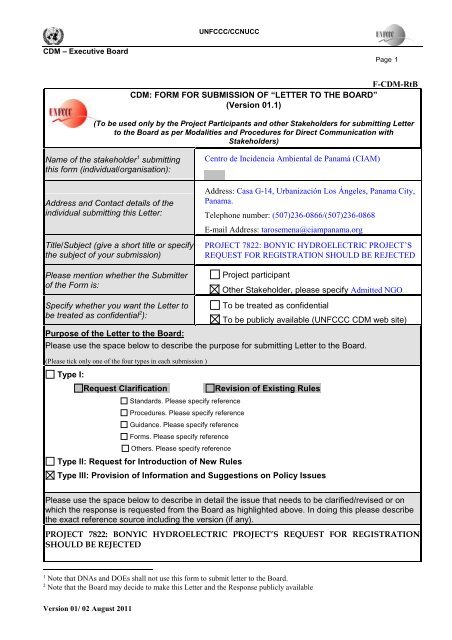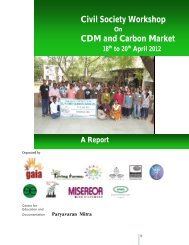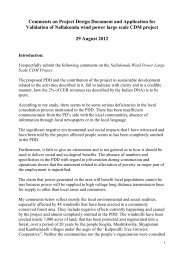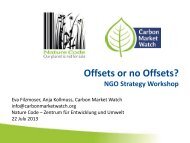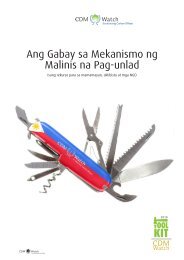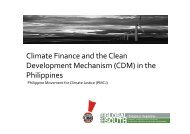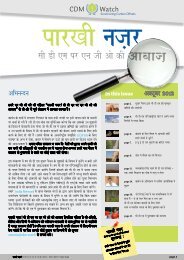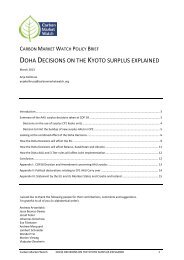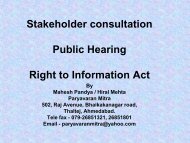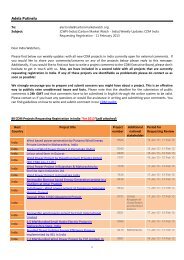Letter PDF - Carbon Market Watch
Letter PDF - Carbon Market Watch
Letter PDF - Carbon Market Watch
You also want an ePaper? Increase the reach of your titles
YUMPU automatically turns print PDFs into web optimized ePapers that Google loves.
UNFCCC/CCNUCC<br />
CDM – Executive Board<br />
Page 1<br />
F-CDM-RtB<br />
CDM: FORM FOR SUBMISSION OF “LETTER TO THE BOARD”<br />
(Version 01.1)<br />
(To be used only by the Project Participants and other Stakeholders for submitting <strong>Letter</strong><br />
to the Board as per Modalities and Procedures for Direct Communication with<br />
Stakeholders)<br />
Name of the stakeholder 1 submitting<br />
this form (individual/organisation):<br />
Address and Contact details of the<br />
individual submitting this <strong>Letter</strong>:<br />
Title/Subject (give a short title or specify<br />
the subject of your submission)<br />
Centro de Incidencia Ambiental de Panamá (CIAM)<br />
Address: Casa G-14, Urbanización Los Ángeles, Panama City,<br />
Panama.<br />
Telephone number: (507)236-0866/(507)236-0868<br />
E-mail Address: tarosemena@ciampanama.org<br />
PROJECT 7822: BONYIC HYDROELECTRIC PROJECT’S<br />
REQUEST FOR REGISTRATION SHOULD BE REJECTED<br />
Please mention whether the Submitter<br />
of the Form is:<br />
Specify whether you want the <strong>Letter</strong> to<br />
be treated as confidential 2 ):<br />
Project participant<br />
Other Stakeholder, please specify Admitted NGO<br />
To be treated as confidential<br />
To be publicly available (UNFCCC CDM web site)<br />
Purpose of the <strong>Letter</strong> to the Board:<br />
Please use the space below to describe the purpose for submitting <strong>Letter</strong> to the Board.<br />
(Please tick only one of the four types in each submission )<br />
Type I:<br />
Request Clarification<br />
Standards. Please specify reference<br />
Procedures. Please specify reference<br />
Guidance. Please specify reference<br />
Forms. Please specify reference<br />
Others. Please specify reference<br />
Type II: Request for Introduction of New Rules<br />
Revision of Existing Rules<br />
Type III: Provision of Information and Suggestions on Policy Issues<br />
Please use the space below to describe in detail the issue that needs to be clarified/revised or on<br />
which the response is requested from the Board as highlighted above. In doing this please describe<br />
the exact reference source including the version (if any).<br />
PROJECT 7822: BONYIC HYDROELECTRIC PROJECT’S REQUEST FOR REGISTRATION<br />
SHOULD BE REJECTED<br />
1<br />
Note that DNAs and DOEs shall not use this form to submit letter to the Board.<br />
2<br />
Note that the Board may decide to make this <strong>Letter</strong> and the Response publicly available<br />
Version 01/ 02 August 2011
UNFCCC/CCNUCC<br />
CDM – Executive Board<br />
Page 2<br />
We welcome the decision by the Executive Board to review the request for registration of Project<br />
7882: Bonyic Hydroelectric Project and respectfully request its rejection.<br />
The Bonyic Hydroelectric Project is a 31.8 MW 3 hydroelectric power plant currently being<br />
constructed (over 50% complete as of September 2013 4 ) on the Bonyic River, within the Bosque<br />
Protector Palo Seco Protected Area, in the Republic of Panama. The Bosque Protector Palo Seco is a<br />
buffer zone for the Talamanca Range-La Amistad Reserves/La Amistad National Park, which is a<br />
World Heritage site and a protected area in Panama and Costa Rica. The affected area is also part of<br />
the traditional territories of the Naso indigenous people 5 .<br />
Our main concerns are:<br />
• That the project fails to meet additionality requirements related to project barriers and prior<br />
consideration.<br />
• The Designated Operational Entity failed to address all comments by stakeholders.<br />
• Registration of the Bonyic Hydroelectric Project would violate international law requirements<br />
regarding common heritage and indigenous people’s rights.<br />
We support these statements in the following facts:<br />
1. The Bonyic Hydroelectric Project fails to meet additionality requirements related to<br />
project barriers and prior consideration.<br />
a. The project does not comply with Barrier Analysis requirements established by Section 7.2.6<br />
of the CDM Project Standard, the Guidelines for objective demonstration and assessment of<br />
barriers, and Section 7.12.12 of the CDM Validation and Verification Standards.<br />
Section 7.2.6 of the CDM Project Standard, the Guidelines for objective demonstration and<br />
assessment of barriers and Section 7.12.12 of the CDM Validation and Verification Standards all<br />
require proof that identified barriers prevent the proposed type of project in the absence of<br />
registration as a CDM project activity; and that they do not prevent the implementation of at least<br />
one of the alternatives.<br />
The project proponent identifies in the PDD two type of barriers, those related to project location and<br />
investment barriers. Concerning project location, the PDD describes three circumstances: the social<br />
sensitivity of the situation of the Naso indigenous people due to a longstanding internal crisis (p. 16-<br />
18 PDD); the biophysical sensitivity of the area due to its high biodiversity (on p. 16 PDD); and the<br />
special requirements related to the project’s location in the Bosque Protector Palo Seco protected area<br />
(p.18 PDD). Concerning the investment barrier, lack of access to long-term debt, the PDD mentions<br />
the Inter-American Development Bank (IDB) refusal to finance the project due to the Naso’s conflict<br />
and the Central American Bank of Economic Integration and Inter American Corporation for<br />
Infrastructure Financing refusal to finance the project due to the project proponent inability to<br />
provide the necessary guaranties (p.18-19 PDD).<br />
3<br />
An amendment of April 2012 to the contract for the electric generation concession between the National Authority for<br />
Public Services and Hidroecológica del Teribe,S.A. (HET) raised the capacity of the project from 30 MW to 31.8 MW(not<br />
32.64 MW). Available in Spanish at http://www.asep.gob.pa/openpdf.php?idresol=AN No.5264-Elec.<br />
4<br />
An amendment of August 2011 to the contract for the electric generation concession between the National Authority for<br />
Public Services (ASEP) and HET postponed the date for the end of construction and start of operation from August 31,<br />
2013 to August 31, 2014. HET alleged that obtaining the necessary permits to start construction in the protected area<br />
delayed the project 11 months, causing them to achieve only 40% of progress by August 2011. This was the fifth time HET<br />
requested and received an extension. Available in Spanish at http://www.asep.gob.pa/openpdf.php?idresol=AN No.4735-<br />
Elec<br />
Version 01/ 02 August 2011
UNFCCC/CCNUCC<br />
CDM – Executive Board<br />
Page 3<br />
All circumstances regarding project location and the loss of financial support due to those<br />
circumstances would affect similarly any proposed project in the area (be it a CDM project or not)<br />
and has no relation with the project being a hydro power plant or more broadly a renewable energy<br />
project 6 . Additionally, the project proponents and the Designated Operational Entity have not<br />
demonstrated how the CDM alleviates each of the identified barriers; or how the construction of the<br />
project can show a progress of more than 50% when the CDM registration that would allegedly<br />
neutralized the barriers has not been achieved.<br />
The first barrier, the internal crisis of the Naso indigenous people, has its origins, as the project<br />
proponent stated in the PDD, in historical and political factors, and as discussed below, the lack of<br />
legal recognition by the Panamanian government of the Naso traditional lands plays an important<br />
role in the conflict. In this scenario, compensation given to community leaders recognized as<br />
“legitimate” in the mist of such a profound internal crisis cannot possibly alleviate the situation, and<br />
has in fact demonstrated to stir more conflict 7 . The second one, the biophysical sensitivity of the area<br />
is mainly caused by a high biological diversity, which can hardly be recognized as a barrier when it<br />
constitutes a common concern of humankind that requires conservation, sustainable use and<br />
equitable sharing of its benefits in accordance with the Convention on Biological Diversity. In this<br />
context, if CDM revenues are to be invested in the area, they should be used towards the ends<br />
described in the Convention, consequently enhancing the sensitivity, not alleviating it. The third<br />
one, the special requirements due to the project’s location in the Bosque Protector Palo Seco<br />
protected area, should likewise not be considered a barrier. Obtaining a concession when operating<br />
within a protected area is a requirement established by law in Panama 8 and compatible with<br />
international law. CDM registration cannot and should not diminish such requirements. Finally, if<br />
the IDB has refused to finance a project in the proposed area on the basis that the indigenous<br />
community conflict does not allow the bank to comply with its social standards, any other project in<br />
the proposed area is likely to obtain the same response until the conflict is resolved. Also the Central<br />
American Bank of Economic Integration and Inter American Corporation for Infrastructure<br />
Financing refusal to finance has not relation with the kind of proposed project, but to the public<br />
nature of its main shareholder, Empresas Públicas de Medellín (EPM), which constrained them from<br />
providing the guaranties requested by the financial institutions.<br />
b. The project does not comply with Prior Consideration requirements established by Section<br />
4.1 of the CDM Project Cycle Procedure, Section 6.3 of the CDM Project Standard and Section<br />
7.12.9 of the CDM Validation and Verification Standards.<br />
5<br />
http://www.edlc.org/cases/communities/naso-of-panama/.<br />
6<br />
Guidelines for objective demonstration and assessment of barriers: “Most projects face some type of barriers. An objective<br />
barrier analysis separates those projects out from other projects for which it can be demonstrated that the CDM has an<br />
actual impact on alleviating barriers. Such analysis rejects projects that face the same barriers with and without the CDM<br />
and where no impact of the CDM can be objectively demonstrated on the barriers.”<br />
7<br />
Despite the lack of mention in the PDD and the Validation Report, factions of the Naso indigenous people have maintained<br />
open opposition to the project. Closings of the project’s access road in 2011 are mentioned in the August 2011 amendment<br />
to the contract between ASEP and HET (footnote 2). In recent days a faction of the Naso have again protested against the<br />
project http://www.laestrella.com.pa/online/impreso/2013/08/21/cierran-paso-a-la-obra-hidroelectrica-bonyic.asp and<br />
http://www.laestrella.com.pa/online/noticias/2013/08/22/martinelli-ordena-a-jefe-policial-abrir-via-hacia-hidroelectricabonyic.asp.<br />
http://m.prensa.com/impreso/nacionales/se-debilita-monarquia-naso/204490<br />
8<br />
See Article 66 of Law 41 of 1998.<br />
http://www.asamblea.gob.pa/APPS/LEGISPAN/<strong>PDF</strong>_NORMAS/1990/1998/1998_159_0225.<strong>PDF</strong>; Resolution AG-0365-<br />
2005 and AG-366-2005 http://www.asamblea.gob.pa/APPS/LEGISPAN/<strong>PDF</strong>_GACETAS/2000/2005/25354_2005.<strong>PDF</strong>.<br />
Version 01/ 02 August 2011
UNFCCC/CCNUCC<br />
CDM – Executive Board<br />
Page 4<br />
The PDD establishes and the Validation Report confirms that the start date for the project activity is<br />
28/08/2007, accordingly the project is considered as an existing project (with a start day on or before<br />
02 August 2008) 9 . For existing projects, Section 4.1 of the CDM Project Cycle Procedure requires<br />
project participants to demonstrate that CDM was seriously considered in the decision to implement<br />
the project activity.<br />
To demonstrate serious consideration, Section 6.3 of the CDM Project Standard and Section 7.12.9 of<br />
the CDM Validation and Verification Standards require, first, “evidence of their awareness of the<br />
CDM prior to the start date of the proposed project activity, and that the benefits of the CDM were a<br />
decisive factor in the decision to proceed with the project”. The only document mentioned in the<br />
PDD and Validation Report that is directly related to this issue is the minute of an EPM Executive<br />
Board meeting, where EPM allegedly decided to finance the project by themselves, considering the<br />
CDM benefits. This minute is referenced in the PDD as Minute 1408 of August 14 th , 2008 10 and in the<br />
Validation Report as Minute 1490 of August 4 th , 2008 11 . This minute would only prove that CDM was<br />
considered to continue the project without external funding after its start date, August 28 th , 2007. No<br />
other minute, contract or document was referenced to in the PDD or the Validation Report to<br />
indicate the CDM being a decisive factor to proceed with the project previous to its start date.<br />
Secondly, Section 6.3 of the CDM Project Standard and Section 7.12.9 of the CDM Validation and<br />
Verification Standards require “evidence that continuing and real actions were taken to secure CDM<br />
status for the proposed project activity in parallel with its implementation”. Section 7.12.9.2 of the<br />
CDM Validation and Verification Standards further elaborates on the gaps of time allowed between<br />
documented evidence. While the Validation Report sustains that there is less than 2 years of a gap<br />
between the documented evidence, many gaps surpassed that amount and some documents without<br />
direct relation to obtaining the CDM status are included to account for some gaps. Additionally, the<br />
contract with MGM for developing the project as a CDM project was signed on March 10th, 2008,<br />
after the start date of the project.<br />
Finally, Section 6.3 of the CDM Project Standard and Section 7.12.9 of the CDM Validation and<br />
Verification Standards require an implementation timeline and a timeline of the events and actions<br />
taken to achieve CDM registration. However, the project timeline included in the PDD, as<br />
implementation timeline, does not include the date when the investment decision was made, the<br />
date when construction works started, the date when commissioning started or the date of start-up;<br />
and, as a CDM registration timeline, it does not include any main pre-registration activity, such as<br />
contract with consultant for CDM/PDD services, grant of <strong>Letter</strong> of Approval, publication of the<br />
PDD, consultation process, agreement with DOE for validation and so on. Regarding the<br />
commissioning date, it is important to mention that HET obtained the contract for the electric<br />
generation concession from the National Authority for Public Services (ASEP) in 1999. The first<br />
deadline imposed by the contract for end of the construction and start of operation was 2005, but<br />
since 2002 HET has requested five extensions to ASEP. The last extension was obtained by appealing<br />
a decision to deny a further extension, and it sets the start of operation in August 2014.<br />
9<br />
p. 13 of the PDD and p. 18 of the Validation Report<br />
10<br />
p. 13 of the PDD.<br />
11<br />
p. 18 of the Validation Report.<br />
Version 01/ 02 August 2011
UNFCCC/CCNUCC<br />
CDM – Executive Board<br />
Page 5<br />
2. The Designated Operational Entity failed to take into account all comments by<br />
stakeholders.<br />
Section 7.5 of the CDM Validation and Verification Standards requires the DOE to take into account<br />
all the comments received during the validation of the proposed project activity and to report the<br />
details of the actions taken to take due account of the comments received. However, several<br />
important comments submitted by stakeholders were not taken into account. Some examples are:<br />
a. From the submission by the Alianza para la Conservación y el Desarrollo (ACD):<br />
Concerning local stakeholders participation, ACD notes that the PDD fails to mention the actions by<br />
Naso protesters who since October 2007 conducted blockades that prevented the advance of the<br />
Project during many months, as well as the disproportionate response by police officials hired by<br />
HET and employees. The DOE did not include this comment in the validation report and hence<br />
provided no response regarding the issue.<br />
Concerning additionality of the project, ACD denounces lack of consideration of other 86<br />
hydropower projects in Panama's pipeline (36 with granted concessions) in the common practice<br />
analysis; legal reforms to promote hydropower generation in 1997 and 2004; and equal prices paid in<br />
the spot market of Panama for hydropower and thermo-electric generators despite the cost of<br />
generation of the second is higher. Once more, the DOE did not include this comment in the<br />
validation report and hence provided no response regarding these issues.<br />
b. From FERN:<br />
FERN expresses concern about the inadequacy of an agreement of direct use of 25% of CDM-derived<br />
income to compensate the indigenous communities. The DOE replies: “By means of the review of<br />
Social and Environmental Management Plan and interview carried out with Naso-Teribe<br />
community, ICONTEC confirmed that HET has a social commitment with the community. In the<br />
same way, an Agreement was signed with the Naso Teribe community which states that 25% of<br />
CDM-derived income would be transferred to the indigenous community”. Since the concern raised<br />
was not about the existence of an agreement with the community, but about it being an unsuitable<br />
mean of compensation for resettlement, this response is inadequate.<br />
FERN refers to the international obligations concerning the UNESCO World Heritage site (explained<br />
below). The comment was ignored by the DOE in its validation report.<br />
c. From Asociación Ambientalista de Chiriquí (ASAMCHI):<br />
ASAMCHI raises its concern for the negotiation with King Tito Santana when Nasos consider him<br />
not legitimized to perform those functions. The DOE replies mentioning interviews with Tito<br />
Santana and other members of the community who consider that all processes have been done<br />
properly, but mentions nothing about trying to reach the Naso faction that opposes the project.<br />
ASAMCHI states its concern about the Panamanian government having attempted to obtain<br />
approval to construct the Bonyic Project since 1998. The DOE replied: “The CDM prior consideration<br />
was assessed by ICONTEC in accordance with the UNFCCC’s standards and guidelines, as it was<br />
stated in clause 3.5.1 on this report.” However, plans to construct the project since 1998 are not<br />
mentioned in clause 3.5.1 or anywhere else in the Validation Report.<br />
Version 01/ 02 August 2011
UNFCCC/CCNUCC<br />
CDM – Executive Board<br />
Page 6<br />
Also to challenge additionality, ASAMCHI mentions HET’s objective to export energy to Costa Rica.<br />
The DOE replies: “The BHP complies not only with the applied baseline and monitoring<br />
methodology but also is align with the Panamanian electrical regulatory framework.” This response<br />
is inadequate since it is not on point to the comment.<br />
d. From Oscar Reyes:<br />
Oscar Reyes mentions 31 new hydroelectric projects expected to be added to the grid in 2013. The<br />
DOE does not explain how these project affect or don’t affect the project’s common practice analysis<br />
and baseline and monitoring methodology.<br />
Oscar Reyes challenges the use of the risk of environmental damage as a barrier to project<br />
implementation. The Validation Report ignores this comment.<br />
e. From International Rivers:<br />
International Rivers mentions the 17 other projects with less than 20 MW in Panama not accounted<br />
for in the additionality analysis. The sections to which the DOE referred do not mention those<br />
projects.<br />
3. Registration of the Bonyic Hydroelectric Project would violate international law<br />
requirements regarding common heritage and indigenous people’s rights.<br />
Panama is a Party to the Convention Concerning the Protection of the World Cultural and Natural<br />
Heritage (UNESCO World Heritage Convention) 12 , which establishes Panama’s duty to ensure the<br />
protection, conservation, presentation and transmission to future generations of the cultural and<br />
natural heritage situated on its territory.<br />
In 2010, the World Heritage Committee identified the construction on the Changuinola and Bonyic<br />
rivers as “highly likely to result in the direct loss of up to 16 species of migratory fish and shrimp, as<br />
well as having potential negative secondary impacts on biodiversity" 13 within the Talamanca Range-<br />
La Amistad Reserves/La Amistad National Park site. Since then, the Committee has repeatedly<br />
asked Panama "to halt all dam constructions until a detailed transboundary strategic environmental<br />
assessment process is undertaken." 14<br />
In its most recent session in July 2013 the Committee:<br />
"Regret[ted] that construction of the Bonyic dam has continued without prior<br />
consideration of the results of the on-going Strategic Environmental Assessment (SEA),<br />
and urge[d] the States Parties to complete it as a matter of priority and in line with<br />
international standards of best practice." 15<br />
It is also important to highlight that Section 7.13 of the CDM Validation and Verification<br />
Standards also requires the assessment of transboundary impacts.<br />
Lastly, indigenous peoples’ rights to communal property and to consultation regarding effects to<br />
their property are recognized by the United Nations Declaration on the Rights of Indigenous<br />
Peoples 16 and the International Labour Organization Convention 169. 17 The UN Special Rapporteur<br />
on the Rights of Indigenous Peoples, James Anaya, has indicated that while the States have the duty<br />
to protect indigenous peoples’ rights, companies have a duty to act with due diligence not to violate<br />
those rights. This duty includes “that companies must not contribute to States' failure to meet their<br />
international obligations in relation to indigenous rights, nor should they endeavour to replace<br />
States in the fulfilment of those obligations.”<br />
Version 01/ 02 August 2011<br />
12<br />
http://whc.unesco.org/en/statesparties/
UNFCCC/CCNUCC<br />
CDM – Executive Board<br />
Page 7<br />
In August of this year, Special Rapporteur Anaya visited Panama and in his report on the visit<br />
recognized the territorial insecurity of the Naso people as particularly alarming and urged the<br />
Panamanian government to grant recognition and protection to their property rights. The Inter-<br />
American Development Bank (IDB) has also recognized the extent of this crisis and, as mentioned<br />
above, in 2005 it stopped considering the Bonyic Hydroelectric Project for financing due to concerns<br />
that the crisis would jeopardize “the processes of information, consultation and building of<br />
consensuses.”<br />
Panama’s failure to legally recognize the Naso homeland as an autonomous indigenous territory<br />
(comarca) despite their presence in the area for centuries has made them a particularly vulnerable<br />
population. Numbering around 3,500 people, the Naso are in serious danger of disappearing as a<br />
culture. Until the government legally recognizes the Naso’s territory and until internal conflict is<br />
resolved, it is unlikely that projects developed in Naso lands will ensure respect for their human<br />
rights. The CDM Executive Board, as a United Nations body, has an obligation to ensure universal<br />
respect for and observance of human rights and fundamental freedoms, and should do all in its<br />
power to prevent violations to the fundamental human rights of the Naso people.<br />
Please use the space below to any mention any suggestions or information that you want to provide<br />
to the Board. In doing this please describe the exact reference source including the version (if any).<br />
We respectfully request the above information be used in the review of Project 7882: Bonyic<br />
Hydroelectric Project and that its request for registration be rejected.<br />
If necessary, list attached files containing<br />
relevant information (if any)<br />
• None<br />
Section below to be filled in by UNFCCC secretariat<br />
Date when the form was received at UNFCCC secretariat<br />
- - - - -<br />
History of document<br />
Version Date Nature of revision<br />
01.1 09 August 2011 Editorial revision.<br />
01 04 August 2011 Initial publication date.<br />
13<br />
http://whc.unesco.org/archive/2010/whc10-34com-20e.pdf<br />
14<br />
Id. See also UNESCO reports in 2011 and 2012: http://whc.unesco.org/archive/2011/whc11-35com-20e.pdf,<br />
http://whc.unesco.org/archive/2012/whc12-36com-19e.pdf<br />
15<br />
http://whc.unesco.org/archive/2013/whc13-37com-20-en.pdf<br />
16<br />
http://daccess-dds-ny.un.org/doc/UNDOC/GEN/N06/512/07/<strong>PDF</strong>/N0651207.pdf?OpenElement<br />
17<br />
http://www.ilo.org/dyn/normlex/en/f?p=1000:12100:0::NO::P12100_ILO_CODE:C169 While Panama has not yet ratified<br />
International Labour Organization Convention 169, Panama is a party to the American Convention on Human Rights and<br />
the Inter-American Court has established that “the obligation to consult, in addition to being a conventional standard, is<br />
also a general principle of International Law.” (Sarayaku v. Ecuador)<br />
Version 01/ 02 August 2011
UNFCCC/CCNUCC<br />
CDM – Executive Board<br />
Page 8<br />
Decision Class: Regulatory<br />
Document Type: Form<br />
Business Function: Governence<br />
Version 01/ 02 August 2011


